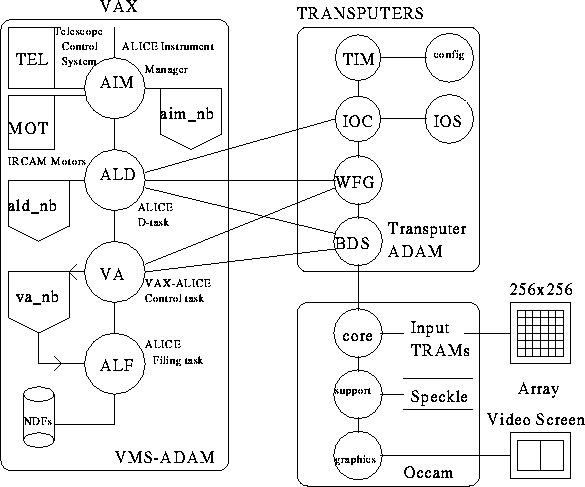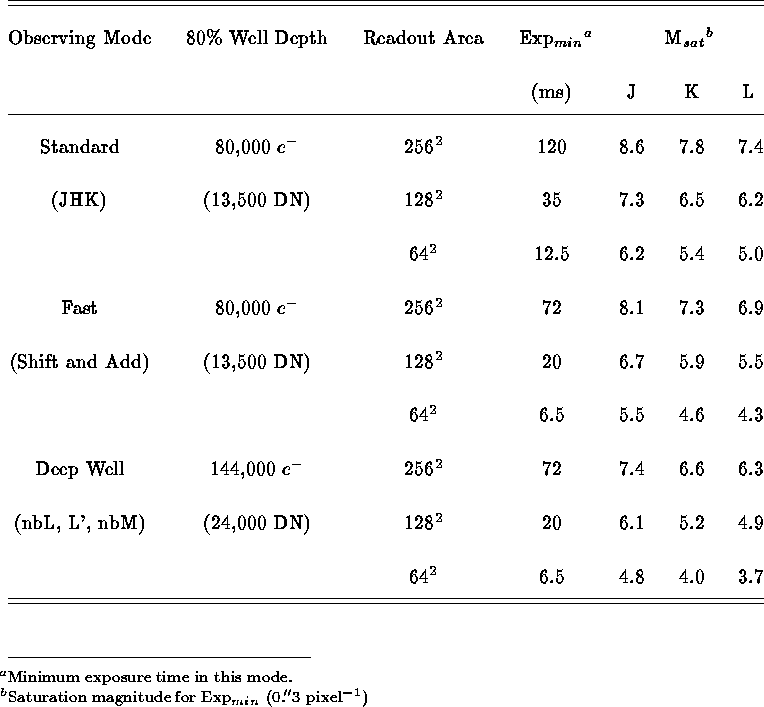 58 InSb array. What was needed was a flexible
and extensible system capable of driving the new generation
of arrays to the limits of their performance, hence the term Array
Limited Infrared Control Environment (ALICE).
58 InSb array. What was needed was a flexible
and extensible system capable of driving the new generation
of arrays to the limits of their performance, hence the term Array
Limited Infrared Control Environment (ALICE).
P. N. Daly and A. Bridger
Joint Astronomy Centre, 660 N. A'ohoku Place, Hilo HI 96720
D. A. Pickup and M. J. Paterson
Royal Observatory, Blackford Hill, Edinburgh EH9 3HJ, Scotland
 array imager, IRCAM3, on UKIRT. Future plans,
including the delivery of a second ALICE to upgrade the UKIRT
long-slit spectrometer, CGS4, are also discussed.
array imager, IRCAM3, on UKIRT. Future plans,
including the delivery of a second ALICE to upgrade the UKIRT
long-slit spectrometer, CGS4, are also discussed.
Infrared astronomy was revolutionized in the 1980s by the advent of array
detectors. One of the first such imaging cameras in regular operation was
IRCAM (McLean et al. 1986), followed by the array spectrometer CGS4
(Mountain et al. 1990), both of which were commissioned onto the 3.8 m United
Kingdom Infrared Telescope (UKIRT) on Mauna Kea, Hawaii. The control
electronics of both these systems, however, were geared to driving the
smaller SBRC 62  58 InSb array. What was needed was a flexible
and extensible system capable of driving the new generation
of arrays to the limits of their performance, hence the term Array
Limited Infrared Control Environment (ALICE).
58 InSb array. What was needed was a flexible
and extensible system capable of driving the new generation
of arrays to the limits of their performance, hence the term Array
Limited Infrared Control Environment (ALICE).
Built at the Royal Observatory in Edinburgh (ROE), ALICE forms the
backbone of the program to upgrade both IRCAM and CGS4 to SBRC  InSb arrays. The ALICE design allows it to operate under
a wide range of conditions such as high resolution low background near
infrared spectroscopy, real-time shift-and-add image sharpening, and
broad-band thermal imaging. To date, the first ALICE has been
commissioned on the telescope and the new instrument, IRCAM3, saw
first light on 1994 April 8 UT.
InSb arrays. The ALICE design allows it to operate under
a wide range of conditions such as high resolution low background near
infrared spectroscopy, real-time shift-and-add image sharpening, and
broad-band thermal imaging. To date, the first ALICE has been
commissioned on the telescope and the new instrument, IRCAM3, saw
first light on 1994 April 8 UT.
The array control system (Pickup et al. 1993) applies well defined, and well controlled, bias and clock voltages to the array, and is also responsible for clocking the appropriate waveform to trigger read, reset, or read-reset operations. It also obtains time stamps from the UKIRT satellite clock and is able to control the secondary mirror in synchronization with the observations. All of these operations may be manipulated under software control from the user interface, thus giving the system considerable flexibility.
The array control system software operates under the transputer ADAM environment (Kelly et al. 1993), and was originally written in parallel FORTRAN, although this will be replaced by a C version when the second ALICE is commissioned. The tasks comprise the time stamping process (TIM), the I/O controllers (IOC and IOS), and the waveform generator (WFG), as shown in Figure 1. The WFG is initialized with full frame read, reset, and read-reset waveforms---other waveforms, for sub-array reads and so forth, are downloaded as required.

Figure: The ALICE Software Map.
Original PostScript figure (10 kB)
The waveform generator hardware includes an Inmos T805-25 transputer with 16
MB of DRAM. The waveform memory has 16 banks of 256k  32-bit
field memory. Each of the 32 bits of the waveform handles one clock signal
(three of which are reserved for system use). Moreover, any of the 16 banks
can hold a single waveform sufficient to drive a full
32-bit
field memory. Each of the 32 bits of the waveform handles one clock signal
(three of which are reserved for system use). Moreover, any of the 16 banks
can hold a single waveform sufficient to drive a full  array.
Banks can also be read out seamlessly so that, if necessary, a waveform can
be loaded across several banks. In this fashion, larger arrays should easily
be accommodated as they become available.
array.
Banks can also be read out seamlessly so that, if necessary, a waveform can
be loaded across several banks. In this fashion, larger arrays should easily
be accommodated as they become available.
The bulk data system (BDS) supports the bi-directional transfer of data between
ALICE and the host system at  50 kB s
50 kB s . Thus a full
. Thus a full
 4-bytes pixel
4-bytes pixel frame takes
frame takes  5s to transfer.
Four MB of on-board RAM are used to buffer the data to allow
asynchronous acquisition of new data.
5s to transfer.
Four MB of on-board RAM are used to buffer the data to allow
asynchronous acquisition of new data.
The bi-directional nature of the data transfer allows data to be passed up to the host computer and, for example, bad pixel masks, color tables, or background frames to be passed down to the transputer sub-system when required by the video display system. The BDS also handles the downloading of waveforms to the WFG when required to trigger different reads of the array and the transputer ADAM messaging traffic. Messages between the host computer (a VAX in the present application), are routed through a B300 TCP-linkbox (ethernet gateway).
The data acquisition system controls the analog conditioning of signals
from the array, conversion to digital inputs for the INMOS link adaptors
via ADCs (14-bit, 2 mega-samples s ), and for the collection
and re-assembly of the full
), and for the collection
and re-assembly of the full  image via a transputer network.
Several frames may be coadded to form an integration before transmission to
a host computer or local disk. There is also a video display system that
updates at
image via a transputer network.
Several frames may be coadded to form an integration before transmission to
a host computer or local disk. There is also a video display system that
updates at  2 Hz, that can show either the current integration or both the
current integration and the coadded image side by side, along with some
simple image analysis (peak pixel in x, y, brightness, etc.).
2 Hz, that can show either the current integration or both the
current integration and the coadded image side by side, along with some
simple image analysis (peak pixel in x, y, brightness, etc.).
ALICE makes extensive use of transputers (>24), mainly T805s with 2 MB of memory each. The 16 input processors are hardwired as a pipeline on the motherboard so each processor, during normal operation, sees every 16th pixel from the array. The ``core'' process running on a single transputer acquires the data from the pipeline and re-assembles the data into full frames. A speckle option has recently been introduced using fiber-optic TRAMs that can ``spurt'' the data to a local (SCSI) disk directly for (very) fast acquisition. The transputer data acquisition sub-system is programmed in Occam and the bootable may be downloaded from either a Sun or a VAX.

Table: IRCAM3/ALICE Observing Modes
Laboratory tests have shown that ALICE is capable of sustaining data rates
for  bytes pixel
bytes pixel frames of
frames of  115 Hz for destructive
reads and
115 Hz for destructive
reads and  85 Hz for non-destructive reads (Chapman et al. 1990). Real-time,
post-detection image sharpening via a shift-and-add algorithm keyed on the brightest
pixel in a sub-area, can be driven on the full array at
85 Hz for non-destructive reads (Chapman et al. 1990). Real-time,
post-detection image sharpening via a shift-and-add algorithm keyed on the brightest
pixel in a sub-area, can be driven on the full array at  35 Hz.
Unfortunately, the IRCAM3 array cannot be driven at these rates
(Puxley et al. 1994). Table 1 summarizes the available ALICE/IRCAM3 observing
modes. The ALICE/IRCAM3 observing regimes include
STARE, ND_STARE, CHOP, ND_CHOP, and Shift-and-Add, presented to the observer
via Starlink's SMS user interface.
35 Hz.
Unfortunately, the IRCAM3 array cannot be driven at these rates
(Puxley et al. 1994). Table 1 summarizes the available ALICE/IRCAM3 observing
modes. The ALICE/IRCAM3 observing regimes include
STARE, ND_STARE, CHOP, ND_CHOP, and Shift-and-Add, presented to the observer
via Starlink's SMS user interface.
The immediate plan is to install and commission the second ALICE as
part of the CGS4 upgrade beginning in 1994 November. The major
parts of this program are modifications to the CGS4 instrument
(hardware) to handle the smaller pixel size in the larger array
(30micron as opposed to 76micron), the introduction of algorithms
into the automated data reduction system to compensate for curved
slits and so forth, and the upgrade of the ALICE software to C. Another
ALICE has been built for use with IRCAM2 on the 4.2m
William Herschel Telescope on La Palma in the Canary Islands.
A second-generation ALICE is being built at the ROE to drive the mid-infrared
imager/spectrometer (Michelle). Given the modularity of the ALICE
design, new components such as faster ADCs or T9000 TRAMs should
easily be accommodated, improving performance by a factor of  10
each.
10
each.
Mountain, C. M., Robertson, D. J., Lee, T. J., & Wade, R. 1990, in Instrumentation in Astronomy VII, Proc. SPIE, Vol. 1235, ed. D. L. Crawford (Bellingham, SPIE), p. 25
Pickup, D. A., Sylvester, J., Paterson, M. J., Puxley, P. J., Beard, S. M., & Laird, D. C. 1993, in Infrared Detectors and Instrumentation, Proc. SPIE, Vol. 1946, ed. A. M. Fowler (Bellingham, SPIE), p. 558
Kelly, B. D., McNally, B. V., & Stewart, J. M. 1993, in Astronomical Data Analysis Software and Systems II, ASP Conf. Ser., Vol. 52, eds. R.J. Hanisch, R.J.V. Brissenden, & J. Barnes (San Francisco, ASP), p. 305
Chapman, A. R., Beard, S. M., Mountain, C. M., Pettie, D. G., Pickup, D. A., & Wade, R. 1990, in Instrumentation in Astronomy VII, Proc. SPIE, Vol. 1235, ed. D. L. Crawford (Bellingham, SPIE), p. 25
Puxley, P. J., Sylvester, J., Pickup, D. A., Paterson, M. J., Laird, D. C., & Atad, E. 1994, in Instrumentation in Astronomy VIII, Proc. SPIE, Vol. 2198, ed. D. L. Crawford (Bellingham, SPIE), p. 350